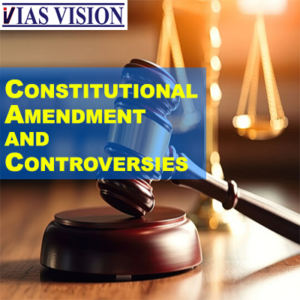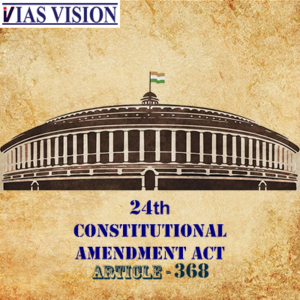CONSTITUTIONAL AMENDMENT AND CONTROVERSIES
controversial amendments of constitution
Constitutional Amendment - Article 368 in The Constitution Of India 1949
CONSTITUTIONAL AMENDMENT AND CONTROVERSIES
Article 368 in The Constitution Of India 1949
- Power of Parliament to amend the Constitution and procedure therefor
(1) Notwithstanding anything in this Constitution, Parliament may in exercise of its constituent power amend by way of addition, variation or repeal any provision of this Constitution in accordance with the procedure laid down in this article
(2) An amendment of this Constitution may be initiated only by the introduction of a Bill for the purpose in either House of Parliament, and when the Bill is passed in each House by a majority of the total membership of that House present and voting, it shall be presented to the President who shall give his assent to the Bill and thereupon the Constitution shall stand amended in accordance with the terms of the Bill: Provided that if such amendment seeks to make any change in
(a) Article 54, Article 55, Article 73, Article 162 or Article 241, or
(b) Chapter IV of Part V, Chapter V of Part VI, or Chapter I of Part XI, or
(c) any of the Lists in the Seventh Schedule, or
(d) the representation of States in Parliament, or
(e) the provisions of this article, the amendment shall also require to be ratified by the Legislature of not less than one half of the States by resolution to that effect passed by those Legislatures before the Bill making provision for such amendment is presented to the President for assent
(3) Nothing in Article 13 shall apply to any amendment made under this article
(4) No amendment of this Constitution (including the provisions of Part III) made or purporting to have been made under this article whether before or after the commencement of Section 55 of the Constitution (Forty second Amendment) Act, 1976 shall be called in question in any court on any ground
(5) For the removal of doubts, it is hereby declared that there shall be no limitation whatever on the constituent power of Parliament to amend by way of addition, variation or repeal the provisions of this Constitution under this article PART XXI TEMPORARY, TRANSITIONAL AND SPECIAL PROVISIONS.

ARTICLE – 368 Amended
CONSTITUTIONAL AMENDMENT AND CONTROVERSIES
The Constitution (Twenty-Fourth Amendment) Act, 1971

- This Amendment aimed to overturn the Supreme Court’s decision in C. Golak Nath v. State of Punjabwhich prohibited Parliament from curtailing Fundamental Rights in any manner.
- A Special Bench of 11 judges had held that Parliament has no power to abolish or abridge constitutional freedoms.
- The Government believed that this decision would not allow it to effectively implement the Directive Principles of State Policy which in some cases entailed an invasion of the Fundamental Rights.
- The 24th Amendment modified Articles 13and 368 to authorize Parliament to freely amend the Fundamental Rights.
Article 13 stated that any law which was inconsistent with the Fundamental Rights was invalid. In Golak Nath, the Supreme Court ruled that the word ‘law’ also included constitutional amendments; as a result, any constitutional amendment which violated the Fundamental Rights was invalid. So Parliament would not be able to use constitutional amendments to curtail the Fundamental Rights.
The 24th Amendment inserted clause (4) to Article 13, which stated that Article 13 would not apply to any constitutional amendments, effectively overturning Golak Nath.
Article 368 lays down the procedure to amend the Constitution. Under the original Constitution, any constitutional amendment would only come into force if two conditions were met: first, if two-thirds of the members of each House of Parliament voted in its favour; second, if it received the assent of the President, who had the option of withholding assent. The Amendment modified the second condition, to provide that the President was bound to give his assent to the Bill - they had no choice.
The 24th Amendment was partially overturned in 1973, when the Supreme Court held in Kesavananda Bharati v. State of Kerala that Parliament could not amend the 'basic structure' of the Constitution. In this case, 11 judges held that certain basic or essential features of the Constitution were beyond the scope of Parliament’s amending powers.
WHAT CONSTITUTES THE BASIC STRUCTURE WAS NOT FULLY ANSWERED & NO CASE HAS EVER EXHAUSTIVELY DEFINED IT - However, since each judge had a separate opinion on which Articles are included in the 'basic structure', the question of what constitutes the basic structure was not fully answered. The cases of Indira Gandhi v. Raj Narain and Minerva Mills v. Union of India before the Supreme Court has added to the 'basic structure', but no case exhaustively defines or lays down the principles that fall under the doctrine.
Both Articles 13 and 368 continue to exist in their amended form. However, through various cases, the Courts have strived to not allow these Articles to undermine the basic structure of the Constitution.
